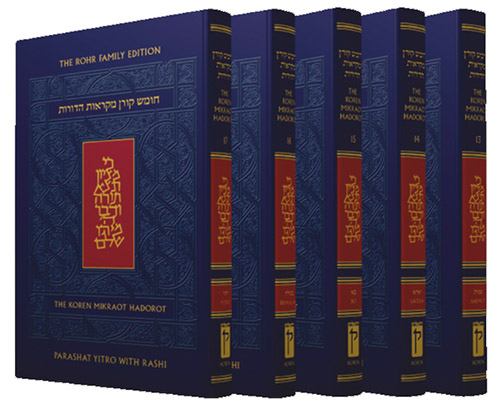
It is not often that one will open a biblical text and find commentaries from the 1st century Jewish-Greek philosopher Philo; traditional Talmudic sources; and the Lubavitcher Rebbe Menachem Mendel Schneerson all in one book. Works of biblical commentary will typically include commentaries from one period of time, such as the Rishonim who lived between the 11th-15th centuries. And many works of biblical exegesis such as Philo can be found in academic texts but not alongside traditional Jewish commentary.
But thanks to Koren Publishers Jerusalem’s new Rohr Family Edition Koren Mikraot HaDorot Series, readers can discover 2,000 years of Jewish wisdom and diverse commentary that will enrich their understanding of the five books of Torah.
Mikraot Hadorot’s editor-in-chief Rav Shai Finkelstein calls this project “monumental,” with over 40 commentaries that span far-flung regions of the words, cultures and periods of time that shaped the outlook of the commentators and influenced their philosophies and interpretations of the biblical texts. Rav Finkelstein, who spent 16 years as a congregational rabbi in Memphis, Tennessee before becoming the spiritual leader of the Nitzanim shul in Jerusalem, spent three years editing the complete work.
The 55-volume set contains one book per parsha, as well as an introductory volume. Each book includes the full biblical text in Hebrew with an English translation by Rabbi Lord Jonathan Sacks, zt”l; the Rashi commentary with English translation and Targum Onkelos; the haftorot for Ashkenazim, Sephardim and Yemenites; and commentaries on the Bible. The commentaries are presented in chronological order and are divided according to three time periods: the Second Temple period through the 12th century, which contains commentaries from the Talmud Bavli and Yerushalmi and various midrashim; the classical period with commentaries from Rashi, Kli Yakar, Rav Sadya Gaon and many others; and the modern era from the 18th century onward, with commentaries from Rabbi Samson Raphael Hirsch, Nechama Leibowitz, Rabbi Joseph B. Soloveitchik and more.
Each volume also contains a timeline outlining the period each commentator lived in, and ends with a section titled “The Biblical Imagination” with essays written by Rav Finkelstein on broader conceptual ideas that weave together multiple commentaries.
“Mikraot Hadorot” places much attention on the historical context that shaped the development of each commentary and the attitudes and approaches to the text that evolved based on the time period and environment they were written in. As an example, one can observe the influence of the scholastic dialectic method that dominated Europe in the style of Ashkenazi Rishonim, who often took a textual approach to biblical interpretation. Their counterparts who lived in Sephardi lands often weaved in philosophical and Kabbalistic elements to their commentaries. Scholars in the modern period often reflected on events of their generation, such as the Holocaust or the establishment of the state of Israel. The Lubavitcher Rebbe focused heavily on education and his commentaries reflect his mission to spread Torah as far and wide as possible.
“Almost everything that you touch, if you don’t know the historical background, you will miss so much,” Rav Finkelstein emphasized. He suggests a variety of approaches to “Mikraot Hadorot.” One can read the cycle of the Torah with the help of the same commentary for each weekly reading. Another option is to read all the different commentaries on a particular piece of text and aim to discern what problem is bothering each of them and how the environment they lived in may have shaped their writings.
“I want the reader to get the sense of the depth and the meaning of parshat hashavua (the weekly Torah portion),” he added. “In every generation the commentary and commentator basically dealt with the issue of the week, and they look to parshat hashavua to find strength, emunah (faith), and meaning, to their lives.”
“Mikraot Hadorot” is one of the many high quality and intellectually stimulating works of Jewish texts introduced by Koren Publishers Jerusalem to make Jewish thought and wisdom more accessible. “Drawing from the best insights of over 60 different Torah commentaries from the Midrash to Nehama Leibowitz, Ramban to the Rav, it [“Mikraot Hadorot”] makes the classic interpretations of the ancient, medieval and modern Jewish world available to hundreds of thousands of families in a way it has never been before,” said Managing Editor at Koren Publishers Jerusalem Yedidya Naveh.
The sages taught that there are “70 faces of Torah.” Indeed, there are so many innovative ways to interpret the biblical texts, and “Mikraot Hadorot” has brought so many of these rich teachings from Jewish history under one roof.
Alisa Bodner is a Fair Lawn native who immigrated to Israel a decade ago. She is a nonprofit management professional who enjoys writing in her free time.










